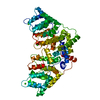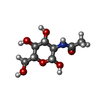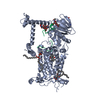+Search query
-Structure paper
| Title | Molecular basis of vitamin-K-driven γ-carboxylation at the membrane interface. |
|---|---|
| Journal, issue, pages | Nature, Vol. 639, Issue 8055, Page 816-824, Year 2025 |
| Publish date | Jan 29, 2025 |
 Authors Authors | Qing Cao / Aaron Ammerman / Mierxiati Saimi / Zongtao Lin / Guomin Shen / Huaping Chen / Jie Sun / Mengqi Chai / Shixuan Liu / Fong-Fu Hsu / Andrzej M Krezel / Michael L Gross / Jinbin Xu / Benjamin A Garcia / Bin Liu / Weikai Li /   |
| PubMed Abstract | The γ-carboxylation of glutamate residues enables Ca-mediated membrane assembly of protein complexes that support broad physiological functions, including haemostasis, calcium homeostasis, immune ...The γ-carboxylation of glutamate residues enables Ca-mediated membrane assembly of protein complexes that support broad physiological functions, including haemostasis, calcium homeostasis, immune response and endocrine regulation. Modulating γ-carboxylation levels provides prevalent treatments for haemorrhagic and thromboembolic diseases. This unique post-translational modification requires vitamin K hydroquinone (KH) to drive highly demanding reactions catalysed by the membrane-integrated γ-carboxylase (VKGC). Here, to decipher the underlying mechanisms, we determined cryo-electron microscopy structures of human VKGC in unbound form, with KH and four haemostatic and non-haemostatic proteins possessing propeptides and glutamate-rich domains in different carboxylation states. VKGC recognizes substrate proteins through knob-and-hole interactions with propeptides, thereby bringing tethered glutamate-containing segments for processive carboxylation within a large chamber that provides steric control. Propeptide binding also triggers a global conformational change to signal VKGC activation. Through sequential deprotonation and KH epoxidation, VKGC generates a free hydroxide ion as an exceptionally strong base that is required to deprotonate the γ-carbon of glutamate for CO addition. The diffusion of this superbase-protected and guided by a sealed hydrophobic tunnel-elegantly resolves the challenge of coupling KH epoxidation to γ-carboxylation across the membrane interface. These structural insights and extensive functional experiments advance membrane enzymology and propel the development of treatments for γ-carboxylation disorders. |
 External links External links |  Nature / Nature /  PubMed:39880037 PubMed:39880037 |
| Methods | EM (single particle) |
| Resolution | 3.3 - 4.4 Å |
| Structure data | EMDB-44935, PDB-9bvk: EMDB-44936, PDB-9bvl: EMDB-44937, PDB-9bvm: EMDB-44939, PDB-9bvo: EMDB-44940, PDB-9bvp: EMDB-44941, PDB-9bvq: EMDB-44942, PDB-9bvr: |
| Chemicals |  PDB-1avc:  ChemComp-6PL:  ChemComp-NAG: |
| Source |
|
 Keywords Keywords | MEMBRANE PROTEIN / LYASE/SUBSTRATE / GGCX / VKGC / Vitamin K / VKCFD / Hemophilia B / Warfarin / Carboxylation / Blood Coagulaton / Calcium homeostasis / LYASE-SUBSTRATE complex / factor X / Protein C / LYASE / TMG / Gla |
 Movie
Movie Controller
Controller Structure viewers
Structure viewers About Yorodumi Papers
About Yorodumi Papers

















 homo sapiens (human)
homo sapiens (human)